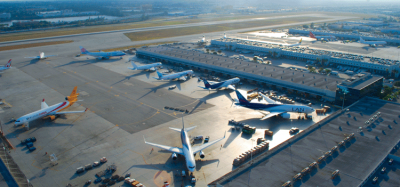Safeguarding health and wellbeing in 10 simple steps
- Like
- Digg
- Del
- Tumblr
- VKontakte
- Buffer
- Love This
- Odnoklassniki
- Meneame
- Blogger
- Amazon
- Yahoo Mail
- Gmail
- AOL
- Newsvine
- HackerNews
- Evernote
- MySpace
- Mail.ru
- Viadeo
- Line
- Comments
- Yummly
- SMS
- Viber
- Telegram
- Subscribe
- Skype
- Facebook Messenger
- Kakao
- LiveJournal
- Yammer
- Edgar
- Fintel
- Mix
- Instapaper
- Copy Link
Posted: 9 October 2019 | Ann Marie Aguilar - International WELL Building Institute | No comments yet
Ann Marie Aguilar, Director of Operations, EMEA, International WELL Building Institute, identifies how to mitigate the negative effects airport environments can have on staff wellbeing and passenger experience.


What are the social and environmental impacts of airports, when potentially hundreds of thousands of travellers can pass through a terminal and the surrounding area each day? The WELL Building Standard (WELL) utilises a holistic, evidence-based approach to improve the physical and mental wellbeing of both passengers and airport staff.
A holistic approach to protecting the workforce
The improved health and wellness of our workforce is front and centre of every conversation now. We’ve made progress against building performance and it is now time to focus on human performance and the contributions better buildings make towards helping humans thrive.
Our buildings can shape our habits and choices, regulate our sleep-wake cycle and drive us toward healthy and unhealthy choices. Though many are aware of the importance of workplace elements incorporating physical activity and nutrition, few understand the impacts that features such as acoustics, lighting, ergonomics and indoor air quality can have on human health. Poor lighting that does not align with our circadian rhythm can negatively aff ect productivity and alertness. Poor indoor air quality can not only cause discomfort and more serious respiratory and skin reactions but can lead to loss of focus. A lack of access to healthy foods and a sedentary lifestyle can contribute to higher obesity rates.
Airports are like cities, each catering to thousands of passengers a year and providing a workplace for thousands of employees. Applying a human-centric lens to airport decision making provides opportunities to improve the health and wellbeing of those who pass through the airports or spend their working hours in these facilities.
Each WELL feature is designed to address the core issues that impact the health and comfort of staff and passengers. Creating healthy corporate cultures that weave in opportunities for mindfulness or connections to nature, and to other people, alongside the chance to rest and recuperate also provide important opportunities to enhance people’s happiness, satisfaction and productivity.
Finding solutions to enhance health and wellbeing
When we take a closer look at the health and wellbeing of staff and passengers, it’s clear that each group experiences unique challenges and requires thoughtful solutions to make working at airports and travelling through them a healthier, happier and more satisfying experience.
Airport staff can be exposed to challenging working conditions that have the potential to seriously impact their health and wellbeing. Across a variety of roles and responsibilities, the detrimental impacts can include exposure to unhealthy air quality through jet fumes, risk of repetitive strain injury when handling bags, increased stress levels from exposure to constant overhead announcements, engine noise or cranky passengers, and working in areas such as security without adequate daylight. Most airport staff work in shifts and are provided with limited space to rest and refuel while on breaks.
Customer-facing airport staff , such as security personnel, can have a direct influence on passenger experience. A growing body of research shows a definite and marked link between employee engagement and customer satisfaction.
Flying is an inherently stressful experience for many people. In particular, overnight flights and time zone changes can drain the body and impact a passenger’s health. Providing an optimal environment for passengers to reduce these additional layers of stress or allow the body to recuperate can not only benefit a passenger’s health, but also make certain airports more attractive for long-haul flights and layovers, thereby increasing airport revenue.
WELL provides a research-based framework, using 10 concepts to evaluate the airport environment:
- Air: Optimise indoor air quality for passengers and staff , evaluating CO2, CO, Ozone, VOCs and Particulate Matter levels, as well as evaluating the impact of jet fumes on indoor air quality
- Water: Hydration is key to healthy travel so easy access to high-quality drinking water will support hydration of staff and passengers
- Nourishment: Making the healthy choice the easy choice can play a key role in promoting healthy eating behaviours in the terminal and beyond
- Light: WELL promotes natural daylight and electric lighting systems that support circadian health as different lighting environments can increase alertness, enhance experience and promote optimal sleep patterns, whilst access to daylight can improve the staff working experience and help passengers adjust to time zone changes
- Movement: Considering the significant limitation of movement on an airplane, airports can counteract this by placing more emphasis on providing physical activity opportunities before or after a flight
- Thermal comfort: Optimise the thermal comfort parameters within the indoor environment to improve staff satisfaction and passenger experience
- Sound: Reduce stress levels of staff and passengers through improved acoustic conditions using optimal zoning and speaker coverage, consistent volume levels and optimal sound quality for PA announcements, as well as building envelope improvements to screen out ramp noise
- Materials: Safeguard human health and minimise exposure to toxins using safer materials inside and limit the use of hazardous chemicals in cleaning, landscaping and outdoor structures
- Mind: WELL supports cognitive and emotional health through design, technology and treatment strategies; restorative spaces with access to nature can provide relief from mental fatigue and stress for passengers and staff
- Community: Airports can provide facilities and support for all members of the travel community, including dedicated spaces for new mothers and families, access for the disabled and supporting travel for the elderly.
Social and environmental impacts
Recognising that human health is inextricably linked to both the health of our planet and the strength of socioeconomic institutions that support everyday life, we see WELL as a unique tool to address social and environmental impacts at airports. WELL makes these connections by offering a balanced, integrated framework of strategies that, while supporting the health of individuals within buildings, also seek to benefit the wider community and surrounding environment by promoting equal access to education, resources and economic opportunity. Mapping WELL v2 features to the 17 United Nations Sustainable Development Goals (SDGs) reveals that WELL spaces are not just healthy spaces – they are inclusive, resilient, sustainable, inspirational spaces with far-reaching impacts.
We’re extremely optimistic about how airports can create a culture of health that supports healthier, more enjoyable spaces where people are excited to work, travel and relax and we can enable the people we care about to thrive.
Biography
Ann Marie Aguilar, Director of Operations, EMEA, joined the IWBI team in 2016 and oversees the day-to-day activities of IWBI across the EMEA region. She supports the business development and technical teams and is the first point of contact for clients and design teams interested in all applications of WELL Certification. She brings to IWBI a technical background in sustainability consulting, having worked for 11 years with Arup Associates.

















